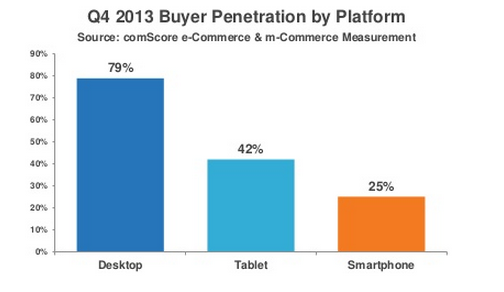Digital Is Digital Wherever It Appears: The Road To Total Convergence
Believe it or not, there are many people who don’t consume digital advertising in silos. While digital marketers are continuously trying to identify how and when an action on a certain device will turn into a conversion, consumers are jumping back and forth between mobile, desktop and tablet, taking their purchase path in different directions […]
Believe it or not, there are many people who don’t consume digital advertising in silos.
 While digital marketers are continuously trying to identify how and when an action on a certain device will turn into a conversion, consumers are jumping back and forth between mobile, desktop and tablet, taking their purchase path in different directions daily.
While digital marketers are continuously trying to identify how and when an action on a certain device will turn into a conversion, consumers are jumping back and forth between mobile, desktop and tablet, taking their purchase path in different directions daily.
Over the past year or so, digital marketers have been obsessed with the rise of mobile and the increase in purchase power of the mobile device. However, this tunnel vision thinking has quieted a powerful media trend: the rise of total media convergence.
When describing “digital advertising” to someone not in the marketing field, the type of platform one refers to doesn’t matter. While some may think of digital advertising as those ads only delivered on a desktop or laptop, others view digital advertising as those that are delivered across all platforms — including mobile.
I recently explained to a cab driver that I’m in the digital advertising field. He then took out his mobile phone, pointed to an ad, and asked if that’s what I meant. So, while this may be the year of mobile to some, I believe that the year of mobile has already passed. Today, it’s about convergence.
Are Devices Cannibalistic To One Another?
 While there may be technical differences between how tablets, desktops and smartphones target consumers, consumers are increasingly using devices for related information, which might include product research or information consumption.
While there may be technical differences between how tablets, desktops and smartphones target consumers, consumers are increasingly using devices for related information, which might include product research or information consumption.
For example, I’m an avid reader of The Economist. While I candidly stopped reading the print version a few years back, I now mostly consume the content on my tablet, my phone and sometimes even my desktop if I’m looking for something specific.
Needless to say, when I read the article on one device, I don’t read it on another. In other words, are mobile, tablet and desktop cannibalistic to one another? And, is mobile and tablet consumption mostly incremental to desktop because more time means more searches, more consumption, etc.?
There are two schools of thought here: on one hand I would argue that if I read an article on my tablet, I probably wouldn’t read it on my phone or laptop. In this case, media cannibalism holds true. My time is up for grabs, and the medium that gets it, wins.
On the other hand, different devices may also mean different roles. Google released a study showing that 90% of consumers switch across screens to complete a task.
Another study from Facebook and market research agency GfK suggested that tablets are considered to be the entertainment hubs, whereas laptops/desktops are used for more important tasks such as managing finances.
The convergence of media means that there will be a stronger emphasis on the value proposition to the consumer at that specific moment. In the example of me reading my article on The Economist, I only need one screen to complete my task.
Yet, for shopping-oriented activities, you may conduct research on the desktop to learn more about a product, but choose to locate the nearest store on your smartphone.
Mobile Is A Key Contributor To Media Consumption
There’s no denying that mobile has made an impact on the consumer purchase funnel. According to comScore, the total U.S. internet usage in minutes has dramatically increased from June 2010 to June 2013, more than doubling the amount of time spent due to rise of tablets and smartphones.
ComScore also reported that today, more than half of the minutes spent online are happening on mobile devices. Sure, mobile is rising and quickly claiming more consumer’s time than desktop. However, all contribute to the sales cycle, and sometimes it might come down to what device is closest in mere proximity to consumers.
While Google reports that purchasing might begin on a smartphone, 61% of those will be continued on a PC or laptop and 4% will continue on a tablet. And even though more purchases may start on mobile, comScore reports that buyer penetration is still highest on desktops.
What this means is that a bigger screen can often lead to a higher conversion rate. To move customers along the decision-making process, you must have all screens covered.

For the marketing industry, integrating desktop and mobile is still a challenge, but companies are getting closer to connecting their digital efforts through login information and device-matching technology.
For other marketers out there, what does total platform convergence mean for you? For one, you must understand your customer’s path to purchase. Research that screens what your constantly-connected customer uses at various stages can help ensure that your digital marketing strategy across platforms aligns.
Keep in mind, for example, that a majority of the consumer population is only sitting behind a desktop from 9-5, so mobile becomes the prime channel to reach a massive population of the consumer market outside of those hours.
Also, understand the challenges of cross-device targeting, but understand the opportunities that strategies such as retargeting can bring.
And finally, constantly test and make mobile an important part of your strategy — but not your full strategy.
In a world where new technologies and data are being tested and where consumer habits are constantly evolving, nothing is perfect or even simple. Yet, the opportunities are endless.
This is the year of convergence, and the year we stop thinking about a tablet as separate from a smartphone or desktop. As far as I’m concerned, mobile is dead. Long live digital media.
Stock images used by permission of Shutterstock.com
Contributing authors are invited to create content for MarTech and are chosen for their expertise and contribution to the search community. Our contributors work under the oversight of the editorial staff and contributions are checked for quality and relevance to our readers. MarTech is owned by Semrush. Contributor was not asked to make any direct or indirect mentions of Semrush. The opinions they express are their own.
Related stories
New on MarTech